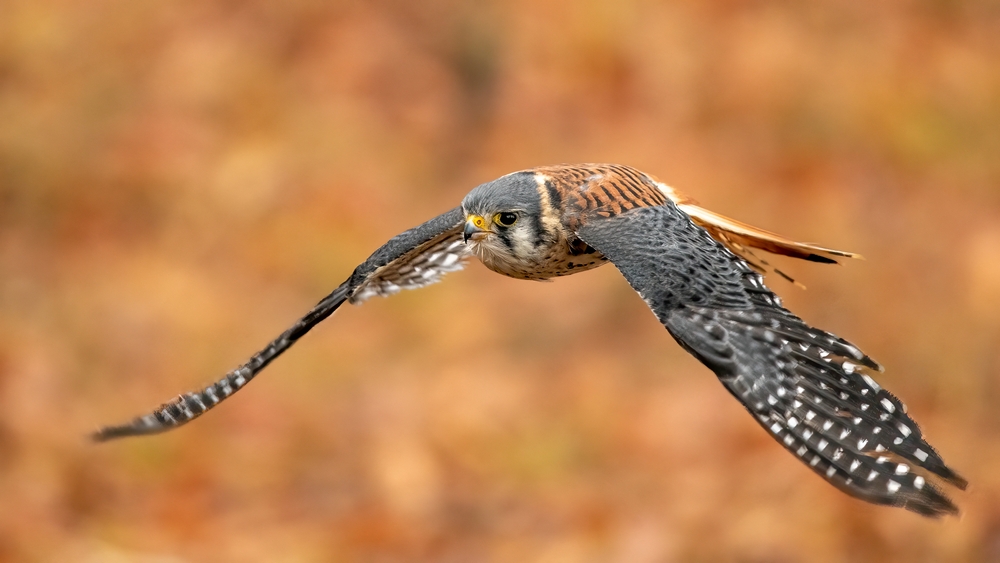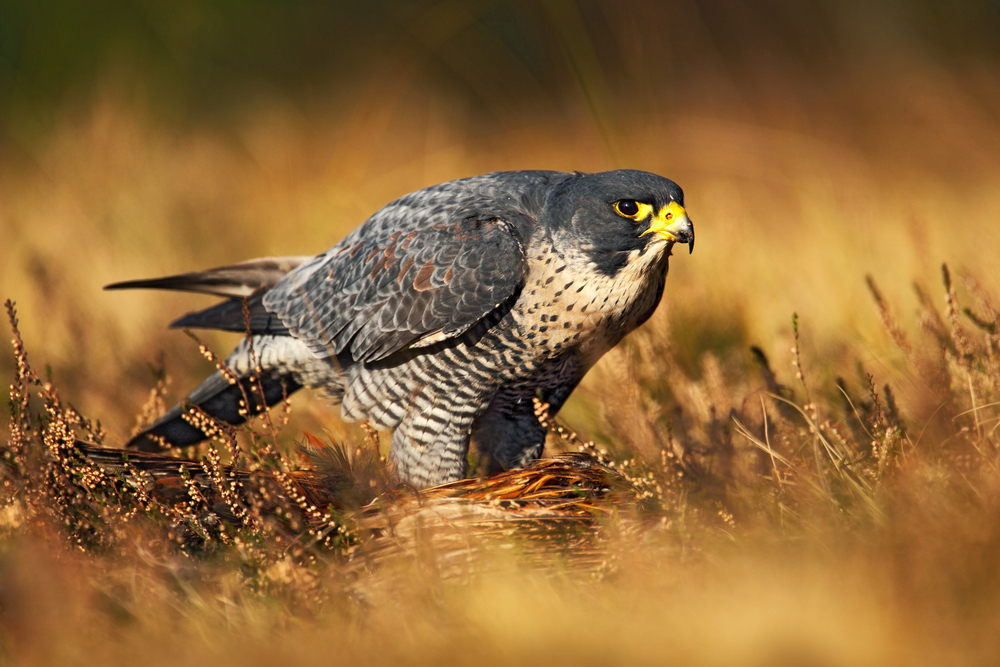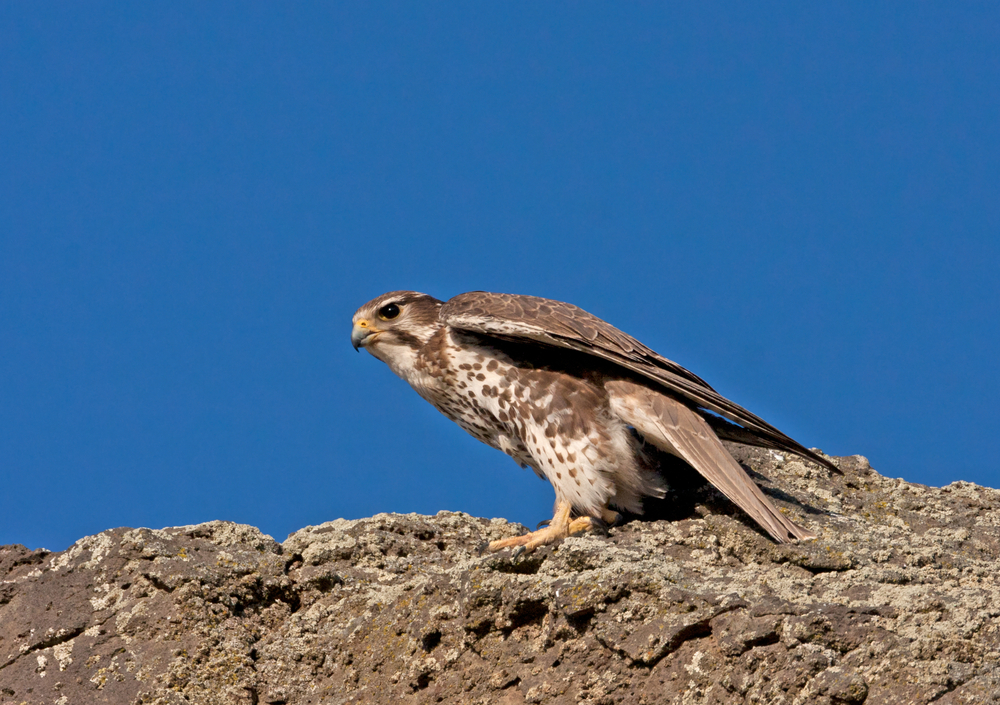The American Kestrel is a falcon, not a hawk. It belongs to the genus Falco and is the smallest falcon in North America.
About
The American Kestrel (Falco sparverius) is the smallest and most widespread falcon in North America, belonging to the Falconidae family. Despite its size, this bird is a bold and skilled hunter, often seen perched on wires, fence posts, or hovering gracefully above fields and roadsides in search of prey. Its adaptability has made it a familiar sight from Alaska and Canada through the United States, Mexico, Central America, and into South America.
Measuring just 22 to 31 centimeters (9 to 12 inches) in length with a wingspan of 51 to 61 centimeters (20 to 24 inches), the American Kestrel is petite compared to other falcons but striking in appearance. Males display blue-gray wings, a rusty-red back and tail, and a double black facial stripe, while females are rufous overall with darker barring. Both sexes have sharp talons, long pointed wings, and a swift, hovering flight.
The kestrel’s diet includes insects, small mammals, reptiles, and birds. In summer, grasshoppers and dragonflies make up much of their food, while in winter, they rely more on rodents and small birds. Their characteristic hunting style often involves hovering in place before plunging onto prey.
Breeding occurs in cavities such as tree holes, cliffs, or nest boxes, as they do not build nests of their own. Females lay four to five eggs, and both parents care for the chicks until fledging. Because they adapt well to artificial nest boxes, they are a popular focus of conservation and education programs.
Although listed as Least Concern, American Kestrels are experiencing population declines in some regions due to habitat loss, pesticide use, and competition for nesting sites.
Colorful, agile, and fearless, the American Kestrel is a beloved falcon that represents both the beauty and resilience of North America’s open skies.
Physical Characteristics
The American Kestrel (Falco sparverius) is the smallest and most colorful falcon in North America, with distinct features that make it easy to recognize.
Plumage:
Males have slate-blue wings with black spots, a rusty-red back and tail with a black band near the tip, and a pale underside with scattered spotting. Females are mostly reddish-brown with dark barring on the wings, back, and tail, and a buff-colored underside with streaking. Both sexes display two bold vertical black facial stripes on each side of the head.
Head and Face:
Their small head is proportionate to their body, with a sharp, hooked beak typical of falcons. The dark facial stripes, often called “mustache” and “sideburn” marks, give them a striking appearance and help reduce sun glare.
Body and Wings:
American Kestrels have a compact body with long, narrow, and pointed wings suited for agile flight. Their wings often appear bent when gliding, and they have a graceful hovering ability rarely matched by other raptors.
Tail:
The tail is relatively long and squared at the tip. Males usually display a rufous tail with a single black subterminal band, while females show multiple narrow dark bands.
Size:
-
Length: 8–12 in (20–31 cm)
-
Wingspan: 20–24 in (51–61 cm)
-
Height at Rest: About 9–10 in (23–25 cm) when perched
Weight:
-
Adult Male and Female: 2.8–5.8 oz (80–165 g)
The American Kestrel’s lightweight build, bright coloration, and ability to hover mid-air distinguish it from other small raptors. Its physical adaptations allow it to thrive in diverse habitats, from open fields to cityscapes.
Reproduction
The reproductive cycle of the American Kestrel (Falco sparverius) follows seasonal patterns and includes distinct stages of courtship, nesting, and fledging.
1. Mating and Courtship:
American Kestrels form monogamous pairs for the breeding season, though some may remain paired for multiple years. Courtship involves aerial displays, food passing from the male to the female, and vocal calls. Males often showcase their hovering ability and deliver prey as part of pair-bond strengthening.
2. Nesting Sites:
Unlike larger raptors, kestrels do not build their own nests. They use natural tree cavities, abandoned woodpecker holes, cliff crevices, or nest boxes provided by humans. Nest sites are typically located in open habitats with nearby hunting grounds.
3. Egg Laying:
The female lays 3–7 eggs per clutch, with 4–5 being the most common. Eggs are creamy or buff-colored with reddish-brown speckles. Laying occurs between April and June, depending on latitude.
4. Incubation:
The incubation period lasts about 28–31 days. The female does most of the incubation while the male hunts and delivers food.
5. Hatching and Care of Chicks:
Chicks hatch asynchronously, covered in white down, and weigh about 0.3–0.4 oz (8–12 g) at birth. The female broods and feeds the young using prey provided by the male during the first two weeks.
6. Fledging and Independence:
Nestlings remain in the cavity for 28–31 days before fledging. After leaving the nest, juveniles may stay nearby and continue to be fed by the parents for another 2–3 weeks while they develop hunting skills.
7. Breeding Success and Frequency:
Most pairs raise a single brood per year, though in southern ranges, some may attempt a second brood if conditions are favorable. Breeding success depends on prey availability and nest site protection.
The American Kestrel’s reproductive strategy of cavity nesting and relatively large clutch size increases its chances of successful rearing despite predation and environmental risks.
Lifespan
The lifespan of the American Kestrel (Falco sparverius) varies considerably between the wild and captivity, influenced by predation, food supply, and environmental conditions.
Lifespan in the Wild:
In their natural habitats, American Kestrels typically live 5–6 years on average, though many do not survive their first year due to predation and harsh conditions. The oldest recorded wild kestrel lived 11 years and 7 months.
Lifespan in Captivity:
With consistent food, veterinary care, and protection from predators, kestrels can live significantly longer under human care. In captivity, they may reach 14–17 years.
Threats to the American Kestrel:
-
Predation: Owls, larger hawks, and snakes often prey on kestrels and their nestlings.
-
Habitat Loss: Agricultural expansion, urbanization, and reduced availability of nesting cavities impact survival.
-
Pesticides & Chemicals: Insecticides can poison prey species, leading to food scarcity and reproductive challenges.
-
Collisions: Strikes with vehicles and structures like windows or fences contribute to mortality.
-
Climate Change: Shifts in weather patterns may affect insect and small mammal populations, altering kestrel food supply.
Conservation efforts, such as installing nest boxes, preserving open hunting grounds, and monitoring populations, are vital to sustaining kestrel numbers.
The American Kestrel’s relatively short lifespan in the wild is balanced by its ability to reproduce annually with relatively large clutches, ensuring population resilience when conditions are favorable.
Eating Habits
The American Kestrel (Falco sparverius) is a versatile and opportunistic predator with hunting methods and a diet adapted to its small size and agile flight.
Diet:
American Kestrels feed on a wide variety of prey. Their diet includes:
-
Insects: Grasshoppers, beetles, crickets, and dragonflies make up a large portion, especially in summer.
-
Small Mammals: Mice, voles, and shrews.
-
Small Birds: Sparrows, starlings, and other passerines.
-
Reptiles & Amphibians: Small lizards, frogs, and occasionally snakes.
Hunting Strategy:
-
Kestrels are renowned for their hover-hunting ability, remaining nearly motionless in the air by rapidly beating their wings while scanning the ground for prey.
-
They also hunt from perches, swooping down quickly when prey is spotted.
-
Once captured, prey is usually killed with a quick bite to the neck or head.
Feeding Behavior:
-
Prey is often consumed on a perch or carried to a feeding site.
-
In breeding season, males provide food for females and chicks, sometimes passing prey mid-air to the female as part of courtship or provisioning.
-
Kestrels tend to store extra prey in cavities or branches for later use.
Success and Adaptability:
American Kestrels are efficient hunters, aided by their keen eyesight, which allows them to detect ultraviolet urine trails of rodents. This vision adaptation increases their success rate in capturing small mammals.
Their flexible diet enables them to survive across diverse habitats, from grasslands and deserts to farmlands and cities.
The American Kestrel’s combination of hovering flight, perch-hunting, and broad dietary range makes it one of the most adaptable raptors in North America.
Uniqueness
The American Kestrel (Falco sparverius) is a remarkable bird of prey, possessing distinctive traits that set it apart from other raptors.
Smallest Falcon in North America:
It holds the title as the smallest falcon on the continent, yet it is also one of the most widespread and common raptors.
Brilliant Plumage:
Unlike most falcons, the American Kestrel displays striking sexual dimorphism in plumage. Males show slate-blue wings with rusty backs and tails, while females are barred and more uniformly rufous. Both sexes share bold black facial stripes.
Hovering Flight:
Kestrels are among the few raptors capable of prolonged hovering, often suspending themselves in place to pinpoint prey below before striking.
Ultraviolet Vision:
They can detect ultraviolet light, which reveals rodent urine trails—an adaptation that helps them locate small mammals even when hidden.
Vocal and Social Behavior:
Known for their high-pitched “klee-klee-klee” calls, kestrels are more vocal than many other falcons. During courtship, males and females engage in aerial displays and prey exchanges.
Adaptability:
Their ability to thrive in grasslands, deserts, farmlands, and even urban areas highlights their ecological flexibility. They readily accept nest boxes, making them a favorite species in conservation efforts.
Ecological Role:
American Kestrels help regulate populations of insects, small mammals, and songbirds, contributing to ecological balance in both wild and agricultural landscapes.
The American Kestrel’s combination of small size, dazzling colors, unique hunting methods, and adaptability makes it one of the most captivating and easily recognized raptors in North America.
Be the First to Share Photos of This Species.
FAQ’s
1. Is the American Kestrel a hawk or a falcon?
2. What is special about the American Kestrel’s hunting style?
American Kestrels are unique for their hover-hunting ability. They can remain suspended in the air while scanning for prey, a behavior rare among raptors.
3. What is the species closest to the American Kestrel?
The species most closely related to the American Kestrel (Falco sparverius) is the Eurasian Kestrel (Falco tinnunculus), which is similar in size and hunting style but found across Europe, Asia, and Africa.
4. How does the American Kestrel compare to other falcons?
How does the American Kestrel compare to other falcons?
The American Kestrel is smaller and lighter than most falcons, such as the Peregrine Falcon. While Peregrines are known for their high-speed dives, kestrels specialize in hover-hunting and catching insects, small mammals, and birds. Their vivid coloration also makes them one of the most strikingly patterned falcons.
5. Which national parks provide the best opportunities to see an American Kestrel?
American Kestrels are widespread and can be seen in many U.S. national parks, especially in grassland, desert, and open habitats. Top viewing locations include:
-
Yellowstone National Park (Wyoming/Montana/Idaho) – seen hunting in open meadows.
-
Grand Canyon National Park (Arizona) – frequently spotted along canyon rims and desert edges.
-
Everglades National Park (Florida) – visible perching near open wetlands.
-
Badlands National Park (South Dakota) – abundant in prairie landscapes.





































































